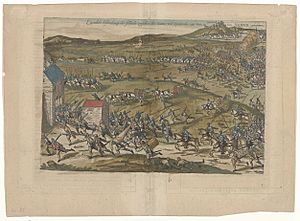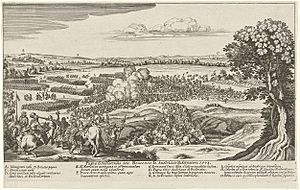Battle of Gembloux (1578) facts for kids
Quick facts for kids Battle of Gembloux |
|||||||
|---|---|---|---|---|---|---|---|
| Part of the Eighty Years' War | |||||||
 Engraving of the Battle of Gembloux by Frans Hogenberg |
|||||||
|
|||||||
| Belligerents | |||||||
| Commanders and leaders | |||||||
Martin Schenck Emanuel Philibert de Lalaing Count of Egmont Marquis d’Havré Henry Balfour |
|||||||
| Strength | |||||||
| 25,000 men | 17,000–20,000 (Only engaged 1,200 cavalry in the first phase of the battle) |
||||||
| Casualties and losses | |||||||
| 8,000–10,000 dead (6,000 killed in the cavalry charge led by Parma) Hundreds of prisoners |
20 dead or wounded (12 dead in action) |
||||||
The Battle of Gembloux was a major fight that happened near Gembloux, in what is now Belgium. It took place on January 31, 1578, during the Eighty Years' War. This war was a long conflict where the Low Countries (like modern-day Netherlands and Belgium) fought for independence from Habsburg Spain.
In this battle, Spanish forces led by Don John of Austria fought against a rebel army. This rebel army was made up of soldiers from many different places, including the Dutch, Flemish, English, and German regions. Don John's nephew, Don Alexander Farnese, led a surprise cavalry attack. This attack caused huge panic among the rebel troops. The Spanish forces won a massive victory. This battle quickly broke apart the unity of the rebel provinces and ended their alliance called the Union of Brussels.
Contents
What Led to the Battle of Gembloux?
Peace Efforts and New Conflicts
In 1576, Spanish soldiers attacked and robbed the city of Antwerp. This event was known as the Sack of Antwerp. After this, both Catholic and Protestant groups in the Low Countries decided to work together. They signed a peace agreement called the Pacification of Ghent. Their main goal was to remove all Spanish troops from their lands.
The Spanish army units (called tercios) did leave for Italy in April 1577. This happened after the new Spanish governor, Don John of Austria, signed a treaty called the Perpetual Edict. Don John was a famous Christian knight and the half-brother of Philip II of Spain. He was well-known for winning the Battle of Lepanto.
Spain Prepares for War
However, in the summer of 1577, Don John started planning a new military campaign. He wanted to fight against the rebels in the Netherlands again. In July 1577, he took control of the Citadel of Namur without a fight. This action made the fragile peace between Catholics and Protestants even more unstable.
Starting in December 1577, Don John received more soldiers. These reinforcements came from Spanish Lombardy. About 9,000 experienced Spanish troops arrived, led by Don Alexander Farnese. He also got 4,000 troops from Lorraine and local soldiers from Luxembourg and Namur. By January 1578, Don John had between 17,000 and 20,000 soldiers ready to fight.
The Rebel Army's Challenges
The rebel alliance, known as the Union of Brussels, had about 25,000 fighting men. But these troops were not well-equipped. They also had poor leadership. Most importantly, they were a very mixed group. They included soldiers from the Netherlands, Flanders, England, Scotland, and Germany. Their religious beliefs also varied greatly, from strong Catholics to strict Calvinists. This made it hard for them to work together.
The Battle of Gembloux Begins
Rebel Army's Retreat
In the last days of January 1578, the rebel army was camped between Gembloux and Namur. Their army was in bad shape, with many soldiers sick. Several of their main leaders were away at a wedding in Brussels. So, the army was commanded by Antoine de Goignies. Other important rebel commanders included the Count of Boussu and Philip, Count of Egmont.
When De Goignies found out that the Spanish army was getting close to Namur, he decided to move his troops. He ordered them to retreat towards Gembloux.
Parma's Surprise Attack
On the morning of January 31, the Spanish army marched towards the rebel forces. The Spanish cavalry (soldiers on horseback) led the way. They were followed by musketeers and infantry (foot soldiers). Don John of Austria and Don Alexander Farnese led the main part of the army.
The Spanish cavalry crossed the Meuse River and caught up with the back of the retreating rebel army. Don John sent messages to his cavalry, now led by Alexander, telling them not to get too close to the enemy. He wanted them to wait for the rest of the Spanish army to arrive. However, Alexander's cavalry moved very fast and far ahead. Alexander saw that the rebel forces were in a bad state. He decided to take a chance and launched a surprise cavalry attack.
After some small fights with the rebel cavalry, the Spanish cavalry completely defeated them. The rebel horsemen fled back towards their main army. This caused huge panic among the rebel troops. Most of the rebel army fell apart, and Parma's cavalry cut down many soldiers as they tried to escape.
The Rebel Army is Destroyed
The rebel army tried to get back in order, but then a cannon and its ammunition exploded. This caused many deaths and even more panic. Meanwhile, some rebel troops, mostly Dutch and Scottish soldiers, tried to set up defenses. But they could not stand against the Spanish musketeers and pikemen (soldiers with long spears).
The Spanish victory was complete. De Goignies and many of his officers were captured. The Spanish also took thirty-four flags and banners, along with all the cannons and supplies of the rebel army. Thousands of rebel soldiers were killed or captured. The Spanish, however, had very few casualties, with only 12 dead and a few wounded. About 3,000 rebels managed to reach Gembloux and closed the city gates. But after talking with the Spanish, they surrendered on February 5. This saved the city from being looted.
What Happened After the Battle?


The big defeat at Gembloux put a lot of pressure on Brussels. Because of this, the States General of the Netherlands (the rebel government) had to leave Brussels and move to Antwerp. Prince William of Orange, who was the main leader of the revolt, also left.
The victory for Don John also meant the end of the Union of Brussels. This battle sped up the splitting apart of the rebel provinces.
Don John died nine months after the battle, likely from a disease called typhus. This happened on October 1, 1578. Alexander Farnese took over as governor-general, just as Don John had wished. Alexander then led the Spanish army to take back large parts of the Low Countries in the years that followed.
On January 6, 1579, the provinces that stayed loyal to Philip II signed the Union of Arras. They promised their loyalty to the Spanish king and recognized Alexander Farnese as their new governor. On the other hand, the provinces that supported the Protestant cause signed their own agreement, called the Union of Utrecht.
See also
 In Spanish: Batalla de Gembloux para niños
In Spanish: Batalla de Gembloux para niños
- List of Dukes of Parma
- List of Governors of the Spanish Netherlands


